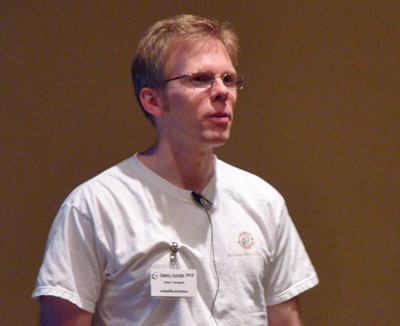
John Carmack speaking at Space Access '10 in Phoenix.
Speaking at the Space Access ’10 conference in Phoenix yesterday, John Carmack noted that the evolution of Armadillo Aerospace from a group of hobbyists to a full-fledged business is nearly complete. “We’ve pretty much become the company we set out to be a number of years ago,” he said, with most of the core team now full-time employees and the company making an operating profit. But the business they’re doing with organizations ranging from the Rocket Racing League to NASA can be “distracting” to their core efforts. “It is kind of getting in the way of building the things we want to build for the vehicles we want to build,” he said. He said he didn’t want to become yet another small aerospace company, “always chasing around their friends and contacts” looking for work.
Carmack, though, has something going for him that many other companies in NewSpace or elsewhere don’t have: some personal wealth. He said his financial situation changed for the better when he sold id Software last year. “Armadillo really was operating at the limit of what I could personally provide,” he said. “It was the limit of what my wife would let me put into it.” He said he’s now able, and willing, to invest more into the company, even though he said he’s proud that it it’s operationally profitable now. “So I probably am going to step up” spending this year on internal projects, he said, even if that means not being profitable.
One area of focus for Armadillo will be resuming a series of “boosted hop” test flights of their vehicle. They started this after the Lunar Lander Challenge was complete, reaching altitudes of 4,000 feet (1,200 meters). “However, while the boost to 4,000 feet was successful, the landing wasn’t,” Carmack said, showing a video of the flight test. With the engine throttled down and the vehicle descending at a speed of about 120 mph (200 km/h), they lost attitude control and the vehicle fell, landing on its side with quite a thud, but no fireball. They now understand that problem and plan resuming boosted hops first at their home site, Caddo Mills airport in Texas, where they can go to 6,000 feet (1,800 meters). From there they’ll go to Spaceport Oklahoma for flights of up to at least 20,000 feet (6,000 meters); higher flights will require going to Spaceport America in New Mexico.
Carmack expressed optimism that Armadillo was close to having all the key technologies needed for a complete suborbital vehicle. “What we’ve got, what we’ve been flying, is pretty damn close to what we need for a reusable suborbital vehicle,” he said.
Carmack also briefly addressed one controversial event from last year: finishing second in Level Two of the Lunar Lander Challenge after a judging decision gave Masten Space Systems one more flight attempt, which they used to make a flight that won first place and $1 million. Despite the experience, he heaped praise on the overarching Centennial Challenges program. “I have to say, Centennial Challenges has to be some of the best money that NASA has ever spent,” he said. But, he added, “I still am bitter about how things finally went down at the end there… No Christmas cards for them.”

Leave a Reply